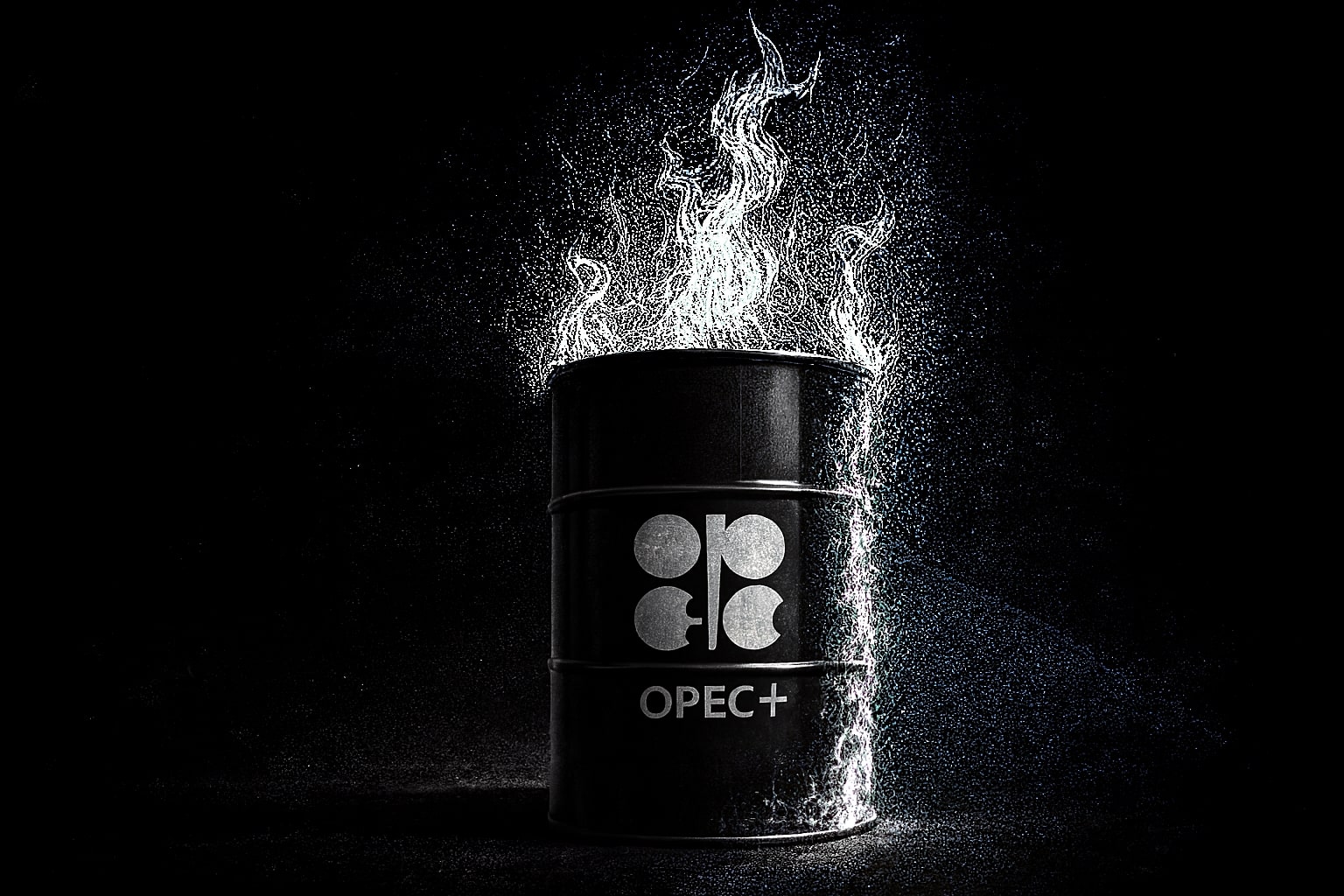
Can WTI Crude Break $70? The Forces Driving Oil Prices Amid Global Economic Shifts
With WTI at $61.68 and Brent pushing $65, is the oil market set for a breakout or more turbulence? What impact will OPEC+ production increases have on future price movements? | That's TradingNEWS
Impact of Global Events on Oil Prices: A Deep Dive Into Crude Oil’s Market Movements
Crude Oil Price Movements Amid U.S. Tariff Talks and OPEC+ Production Increase
Crude oil prices experienced a rise this week, buoyed by U.S. President Donald Trump’s decision to extend the deadline for a trade deal with the European Union (EU) to early July. This extension, granted after European Commission President Ursula von der Leyen requested more time to finalize the deal, provided temporary relief to global markets. At the time of writing, Brent crude was trading at $64.96 per barrel, while West Texas Intermediate (WTI) crude was at $61.68 per barrel. This marks a brief uptick following a tough week, influenced by broader market uncertainties, including negotiations between the U.S. and Iran and OPEC+ production hikes.
However, despite the positive market reaction to the tariff delay, the market is still facing headwinds. OPEC+ has reportedly agreed to increase oil production by another 411,000 barrels per day in July, following the same increase in June. This decision could potentially counteract any price increases driven by trade deal optimism, as the market grapples with fears of oversupply. The planned production hike is part of OPEC+’s strategy to recover market share and maintain its influence, but it risks keeping oil prices in check as the supply-demand balance becomes skewed.
U.S. and Iran Nuclear Deal Talks Impacting Oil Price Outlook
Simultaneously, the ongoing talks between the U.S. and Iran regarding Iran’s nuclear program continue to influence the oil market. These negotiations have shown limited progress so far, but both parties remain open to further talks. This situation raises the possibility that Iranian crude might not return to the global market soon, as the sanctions remain in place. Such uncertainty provides some cushion to current oil prices, preventing a steep decline despite the looming threat of oversupply from OPEC+ and rising U.S. production.
As of now, the U.S. is facing the challenge of its own debt crisis, with national debt surpassing $36.8 trillion. This economic backdrop is likely to have a more long-lasting effect on oil prices, especially as U.S. Treasury yields continue to surge. The U.S. 30-year bond yield reached 5.15%, marking its highest point since October 2023. This shift has led to growing concerns about higher debt servicing costs and the potential for reduced investor confidence in U.S. assets. As a result, investors are increasingly turning to alternative assets like crude oil, which has become a potential safe haven.
OPEC+ Strategy: Pressure on U.S. Shale Producers
OPEC+, in its ongoing efforts to reclaim market share from U.S. shale producers, is considering additional production hikes in July. This is part of a broader strategy that mirrors the 2014 oil price war, which aimed to undercut U.S. shale by flooding the market with cheap oil. Despite technological advancements and increased efficiency in U.S. shale production, the high costs of drilling and wastewater disposal continue to make it a vulnerable market.
U.S. shale producers face significant challenges. According to the latest Dallas Fed Energy Survey, shale drillers require $61 per barrel of WTI crude to remain profitable. This number rises to $70 per barrel for the Permian Basin. With current prices hovering around $60, many shale operators may struggle to sustain production, especially if OPEC+’s strategies lead to lower prices in the future.
While a price war could harm all producers, it is particularly detrimental to the smaller shale operators, who are facing rising production costs and operational inefficiencies. Even large U.S. oil companies, like ExxonMobil, are not immune to the impacts of these price wars. However, OPEC+ has indicated that a more strategic, subtle price war may be on the horizon, designed to exert long-term pressure on U.S. shale without triggering immediate catastrophic losses for all involved.
Ongoing Risks and Challenges for Global Oil Supply
Beyond the geopolitical and economic pressures, the global oil market faces environmental and logistical challenges that could further disrupt supply chains. For instance, the recent sinking of the MSC Elsa 3, a Liberia-flagged cargo ship carrying 640 containers and significant quantities of marine fuel, raised concerns about potential oil spills. The ship was carrying 84 metric tons of diesel and 367 metric tons of furnace oil. As the Indian Coast Guard responds to this spill, the incident highlights the vulnerabilities in global oil transportation, especially when dealing with hazardous materials.
Additionally, the growing tensions in the Gulf of Finland, where Russian military vessels have begun escorting oil tankers, reflect the increasing complexity of securing global oil supply routes. These geopolitical risks could continue to weigh on market sentiment, particularly in Europe and the surrounding regions.
Price Forecast: Can WTI Reach $70 Again?
Looking ahead, WTI crude is poised at a critical juncture. Prices have fluctuated between $55 and $64 per barrel over the past month, with analysts predicting that the commodity could test resistance levels near $65 in the short term. A sustained rally above $65 could set WTI crude on a trajectory toward $70 per barrel, especially if the U.S. Federal Reserve holds interest rates steady and the global economy shows signs of stabilization.
However, any sudden moves by OPEC+ or geopolitical developments in the Middle East could derail this potential rally. The market remains highly sensitive to shifts in global oil supply, with OPEC+’s decisions on production cuts or increases continuing to play a pivotal role in determining the price direction for crude oil.
Conclusion: The Complex Factors Affecting Oil Prices
Crude oil prices are currently caught between bullish factors, such as President Trump's tariff extension and the potential for further negotiations with Iran, and bearish forces, including OPEC+’s planned production hikes and ongoing geopolitical risks. While Brent and WTI prices have shown some resilience, the outlook remains uncertain. Market participants will need to closely monitor OPEC+’s actions, U.S. shale production costs, and the broader economic environment to gauge the true direction of oil prices in the coming months.
That's TradingNEWS
Read More
-
SMH ETF: NASDAQ:SMH Hovering at $350 With AI, NVDA and CHIPS Act Fueling the Next Move
16.12.2025 · TradingNEWS ArchiveStocks
-
XRP ETFs XRPI and XRPR: Can $1B Inflows Lift XRP-USD From $1.93 Back Toward $3.66?
16.12.2025 · TradingNEWS ArchiveCrypto
-
Natural Gas Price Forecast: NG=F Falls to $3.80–$3.94 as Warm Winter Kills $5.50 Spike
16.12.2025 · TradingNEWS ArchiveCommodities
-
USD/JPY Price Forecast - USDJPY=X Slides, BoJ 0.50% Hike, Fed Cut and NFP Set the Next Big Move
16.12.2025 · TradingNEWS ArchiveForex



















